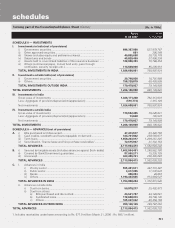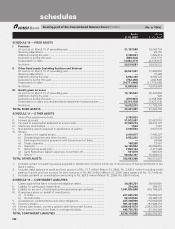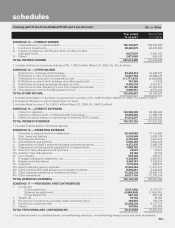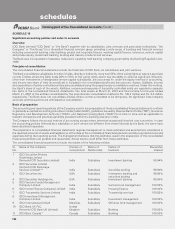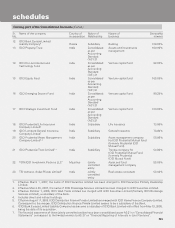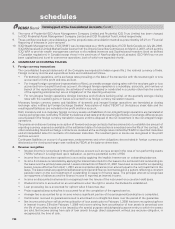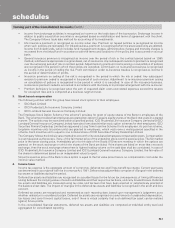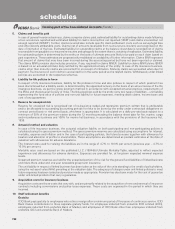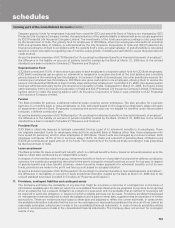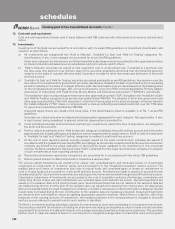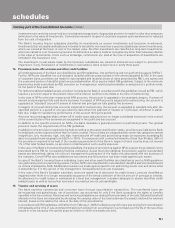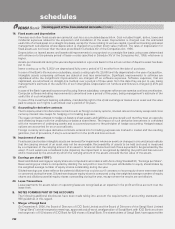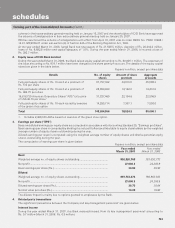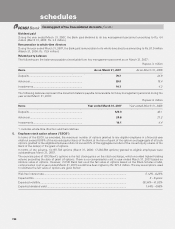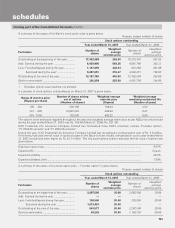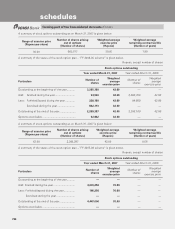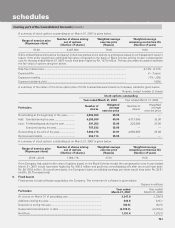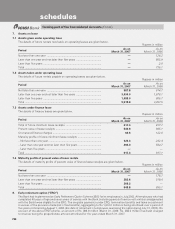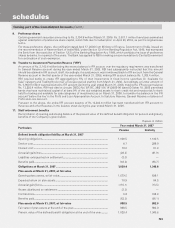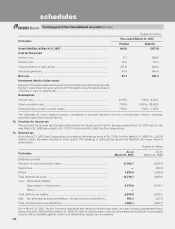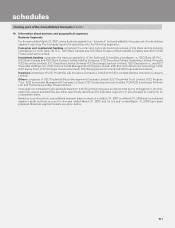ICICI Bank 2007 Annual Report Download - page 131
Download and view the complete annual report
Please find page 131 of the 2007 ICICI Bank annual report below. You can navigate through the pages in the report by either clicking on the pages listed below, or by using the keyword search tool below to find specific information within the annual report.
F61
schedules
investments are carried at cost arrived at on a weighted average basis. Appropriate provision is made for other than temporary
diminution in the value of investments. Commission earned in respect of securities acquired upon devolvement is reduced
from the cost of acquisition.
The Bank’s housing finance subsidiary classifies its investments as current investments and long-term investments.
Investments that are readily realisable and intended to be held for not more than a year are classified as current investments,
which are carried at the lower of cost or the market value. All other investments are classified as long-term investments,
which are carried at cost. However a provision for diminution in value is made to recognise any other than temporary decline
in the value of investments. Costs such as brokerage, commission etc. paid at the time of acquisition of investments are
included in the investment cost.
The investments in real estate made by the insurance subsidiaries are valued at historical cost subject to provision for
impairment, if any. Revaluation of investments in real estate is done at least once in every three years.
14. Provisions/write-offs on loans and other credit facilities
All credit exposures of the Bank are classified as per RBI guidelines, into performing and non-performing assets (“NPAs”).
Further, NPAs are classified into sub-standard, doubtful and loss assets based on the criteria stipulated by RBI. In the case
of corporate loans, provisions are made for sub-standard and doubtful assets at rates prescribed by RBI. Loss assets and
the unsecured portion of doubtful assets are provided/written off as per the extant RBI guidelines. Subject to the minimum
provisioning levels prescribed by RBI, provision on homogeneous retail loans/receivables is assessed at a portfolio level,
on the basis of days past due.
For restructured/rescheduled assets, provision is made by the Bank in accordance with the guidelines issued by RBI, which
requires a provision equal to the present value of the interest sacrifice to be made at the time of restructuring.
In the case of NPAs other than restructured NPA accounts, the account is upgraded to the standard category, if arrears of
interest and principal are fully paid by the borrower. In respect of NPA accounts subjected to restructuring, the account is
upgraded as “standard” account if arrears of interest and principal are fully paid by the borrower.
In respect of non-performing loan accounts subjected to restructuring, the account is upgraded to standard only after the
specified period i.e. a period of one year after the date when first payment of interest or of principal, whichever is earlier,
falls due, subject to satisfactory performance of the account during the period.
Amounts recovered against debts written off in earlier years and provisions no longer considered necessary in the context
of the current status of the borrower are recognised in the profit and loss account.
In addition to the specific provision on NPAs, the Bank maintains a general provision on performing loans. The general
provision meets the requirements of the RBI guidelines.
In addition to the provisions required to be held according to the asset classification status, provisions are held by the Bank
for individual country exposure (other than for home country). The countries are categorised into seven-risk categories namely
insignificant, low, moderate, high, very high, restricted and off-credit and provisioning made on exposures exceeding 90
days on a graded scale ranging from 0.25% to 100%. For exposures with contractual maturity of less than 90 days, 25% of
the provision is required to be held. If the country exposure (net) of the Bank in respect of each country does not exceed
1% of the total funded assets, no provision is maintained on such country exposure.
In the case of the Bank’s investment-banking subsidiary, the policy of provisioning against NPAs is as per the prudential norms
prescribed by the RBI for non-banking financial companies. As per the policy adopted, the provision against sub-standard
assets are determined, taking into account management’s perception of the higher risk associated with the business of
the company. Certain NPAs are considered as loss assets and full provision has been made against such assets.
In case of the Bank’s housing finance subsidiary, loans and other credit facilities are classified as per the NHB guidelines
into performing and non-performing assets. Further, NPA’s are classified into sub-standard, doubtful and loss assets based
on criteria stipulated by NHB. Additional provisions are made against specific non performing assets over and above what
is stated above, if in the opinion of the management, increased provisions are necessary.
In the case of the Bank’s Canadian subsidiary, loans are stated net of allowance for credit losses. Loans are classified as
impaired when there is no longer reasonable assurance of the timely collection of the full amount of principal or interest.
An allowance for credit losses is maintained at a level that management considers adequate to absorb identified credit
related losses as well as losses that have been incurred but are not yet identifiable.
15. Transfer and servicing of assets
The Bank transfers commercial and consumer loans through securitisation transactions. The transferred loans are
de-recognised and gains/losses, net of provisions, are accounted for only if the Bank surrenders the rights to benefits
specified in the loan contract. Recourse and servicing obligations are reduced from proceeds of the sale. Retained beneficial
interests in the loans are measured by allocating the carrying value of the loans between the assets sold and the retained
interest, based on the relative fair value at the date of the securitisation.
In accordance with RBI guidelines, with effect from February 1, 2006, the Bank accounts for any loss arising from securitisation
immediately at the time of sale and the profit/premium arising from securitisation is amortised over the life of the securities
issued or to be issued by the special purpose vehicle to which the assets are sold.
forming part of the Consolidated Accounts (Contd.)


